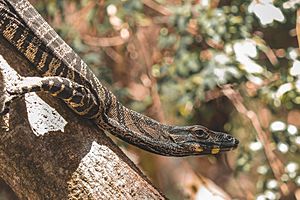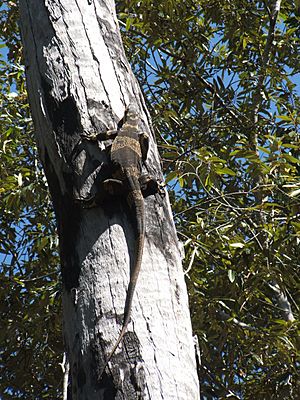Lace monitor facts for kids
Quick facts for kids Lace monitor |
|
|---|---|
 |
|
| Conservation status | |
| Scientific classification | |
| Genus: |
Varanus
|
| Species: |
varius
|
| Synonyms | |
|
Lacerta varia White, 1790 |
|
The lace monitor or tree goanna (Varanus varius) is a large lizard from the monitor lizard family. It lives in eastern Australia. These impressive lizards can grow up to 2 meters (about 7 feet) long and weigh up to 14 kilograms (about 30 pounds).
The International Union for Conservation of Nature (IUCN) lists the lace monitor as a "least-concern species." This means they are not currently in danger of disappearing.
Contents
About the Lace Monitor
Naming and History
The lace monitor was first described in 1790 by John White, a surgeon from New South Wales. He called it the "variegated lizard." Later, in 1820, a German naturalist named Blasius Merrem created the group (genus) called Varanus for monitor lizards, and the lace monitor was one of the first lizards placed in this group.
Sometimes, you might see a lace monitor with a different pattern. This is called "Bell's phase" lace monitor. It was named after an English zoologist, Thomas Bell. This special pattern is a natural variation, like how some people have red hair and others have brown hair.
Scientists have studied the DNA of lace monitors. They found that there are three main groups of these lizards across Australia. These groups separated from each other millions of years ago. The lace monitor is also a close relative of the famous Komodo dragon.
Local Aboriginal peoples have their own names for the lace monitor. For example, the Eora and Dharug people of the Sydney area called it wirriga. The Wiradjuri people of southern New South Wales called it gugaa.
Appearance
The lace monitor is the second-largest monitor lizard in Australia. Only the perentie is bigger. Lace monitors can reach up to 2 meters (about 7 feet) in total length. This includes their long, slender tail, which is about 1.5 times longer than their head and body.
Male lace monitors are usually larger than females. Males become ready to breed when their body (without the tail) is about 41.5 centimeters (16 inches) long. Females are smaller, becoming ready to breed when their body is about 38.5 centimeters (15 inches) long.
The heaviest lace monitors can weigh up to 14 kilograms (30 pounds). However, most adult lace monitors are much lighter.
Patterning
Lace monitors come in two main patterns. The most common type is dark grey to bluish-black. It has many scattered cream-colored spots. The head is black, and the snout has clear black and yellow stripes that go under the chin and neck. The tail has thin black and cream bands.
The other type is called Bell's form. This type is usually yellow-brown or yellow with fine black spots. It has wide, black or dark brown bands from its shoulders all the way to its tail. The top of its head is black. Bell's form is often found west of the Great Dividing Range in Queensland and New South Wales.
Where They Live and Their Home
These common lizards live in eastern Australia. Their range stretches from Cape Bedford in Queensland all the way down to southeastern South Australia. They live in both open and dense forests. Lace monitors often travel long distances, sometimes up to 3 kilometers (nearly 2 miles) in a single day, looking for food.
Lace monitors are mostly active from September to May. During cooler weather, they become less active. They find shelter in tree hollows, under fallen trees, or beneath large rocks to stay warm and safe.
Behaviour
Despite their large size, lace monitors are excellent climbers. They can even climb brick walls! Young lace monitors spend even more time in trees than adults. Some lace monitors have been known to live in the same tree for many years.
Reproduction and Life Cycle
In areas with different seasons, lace monitors usually breed during the summer.
During breeding season, male lace monitors will fight each other. They stand on their hind legs and grapple (wrestle). Sometimes, up to six males might gather around a female to try and court her. Mating can last for several hours.
Female lace monitors lay their eggs in active termite nests. These nests can be on the ground or in trees. On average, a female lays about eight eggs, but sometimes as many as 12. If there aren't enough termite nests, females might fight over them. They might also lay their eggs in burrows or hollow logs. The eggs stay in the nest over the winter and hatch about 6 to 7 months later. Baby lace monitors stay near the nest for about a week or more before leaving. Females might even return to the same termite nest to lay eggs again in the future. These lizards can live for over 20 years!
Feeding
Lace monitors eat a variety of foods. Their diet usually includes insects, other reptiles, small mammals, birds, and birds' eggs. They also eat dead animals (carrion) they find. Lace monitors usually look for food on the ground. If they feel threatened, they will quickly climb a nearby tree for safety.
They sometimes look for food in places where people live. They might visit chicken coops to find poultry and eggs. They also sometimes search through garbage bags and bins in picnic areas.
Lace monitors are sometimes hunted by dingoes and large birds of prey. For Aboriginal peoples, lace monitors were a traditional food. Their fat was especially valued for medicine and for use in ceremonies.
Lace monitors often attack the large nests of scrub turkeys to steal their eggs. You might see injuries on their tails from male scrub turkeys pecking them to chase them away.
Can Their Bites Be Harmful?
In 2005, some researchers found that all monitor lizards might have a mild venom. Before this, people thought that monitor lizard bites caused infections because of bacteria in their mouths. However, the research showed that the immediate effects, like swelling and pain, were more likely caused by something similar to venom.
When a lace monitor bites a hand, it can cause swelling very quickly. It can also cause problems with blood clotting in that area and a sharp pain that can travel up the arm. This pain can last for several hours. Scientists are still studying these effects.
Uses by People
The Wiradjuri people traditionally ate lace monitors. They believed that lace monitors caught coming down from trees tasted better than those caught on the ground. The Dharawal people ate the species' eggs, collecting them from sand on riverbanks.
Lace monitors are also sometimes kept as exotic pets in captivity.
Gallery
-
Goanna coming down a tree outside Cooktown, Queensland
-
Wild lace monitor in Brisbane Forest Park, Queensland
-
Variety: Common form of patterning, Cairns, Queensland
-
Lace monitor (Glenrock State Conservation Area), Newcastle, New South Wales
-
Lace monitor at the pass, Byron Bay, New South Wales
Images for kids
See also
 In Spanish: Varano arborícola para niños
In Spanish: Varano arborícola para niños





















